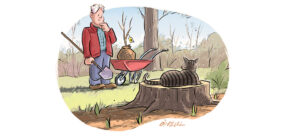
The Tomato’s Last Hurrah
Summer’s carefree days have drawn to a close, but much of the bounty is still with us. Now’s the time to use up every bit of the tomato’s goodness
By Jane Lear
When I was a child, no one I knew cooked pasta (what we called noodles) with tomato sauce at home. In our part of the South, that sort of food was considered not just ethnic, but positively exotic, enjoyed as a special treat at the lone Italian restaurant in town. So although a college roommate introduced me to Ragú — we both thought it was pretty good — I didn’t have what you might call a relationship with tomato sauce until I moved to New York City in the late 1970s.
By sheer good fortune, I landed a job at Alfred A. Knopf, the legendary publishing house, and among the luminaries who graced the halls was Marcella Hazan, author of the instant classics The Classic Italian Cook Book and More Classic Italian Cooking. (Both books are combined in Essentials of Classic Italian Cooking, published by Knopf almost 20 years later.)
Mrs. Hazan’s recipe for Tomato Sauce with Onion and Butter, from the first book, is at once devastatingly simple and life-changing. Aside from pasta and cheese, it lists just four ingredients: tomatoes (fresh or canned), one onion, five tablespoons of butter, and salt. That recipe, which is easily available online, has long been famous for being a gift to home cooks everywhere; periodically, it is rediscovered and wins a whole new fan base.
I made tomato sauce the Marcella way for years. Eventually, though, I branched out, impelled by curiosity and the fact that during the end of tomato season, God will strike me dead if I let a single soft-ripe heirloom go to waste. That’s how I found out that a sauce gets complexity and a good balance of acidity and fruity sweetness from a mixture of varieties, and those juicy heirlooms were more interesting to play with than the pulpier plum (Roma) types.
The basic sauce below is extremely versatile — it’s what my husband and I reach for when making pasta and pizza. It’s wonderful drizzled over flat fresh romano beans, a slab of meatloaf, or polenta. And it seems to taste even better when made with the last of the year’s tomatoes. I freeze as much of it as I can because the jar in the fridge will be gone in no time flat.
By the way, the key to a great tomato sauce is the right pot. You want something heavy-bottomed, to discourage scorching, and with a wide surface area, to aid evaporation. The less time the tomatoes spend reducing, the fresher and more immediate the flavor will be.
A few personal asides on tomato prep: Some people like to peel and seed tomatoes before making sauce; others feel it’s more efficient to toss everything into the pot, then pass the cooked sauce through a food mill to get rid of the gnarly bits.
I generally prefer doing the work on the front end, but unlike many folks, I don’t blanch the tomatoes in boiling water first. Instead, I plunk them in a bowl, pour a kettle of boiling water over them and make myself a cup of tea while I’m at it. By the time I’ve gotten a sieve organized over another bowl, the tomatoes can be eased out of the hot water one by one; with a little help from a paring knife, the skins slip right off.
When seeding tomatoes, first cut them in half crosswise — around the equator — exposing the seed pockets. Use a finger to loosen the seeds in each pocket, then empty the tomato halves over the sieve.
To save every drop of the juices, I don’t chop the tomatoes on a cutting board, but instead in my hand, over the sieve. My tool of choice is a Dexter Russell oyster knife; the straight-edged blade is dull yet can still get the job done, the rubber handle is grippy in a wet hand, and the curved, rounded tip is ideal for flicking errant seeds out of the way. The chopped tomatoes go in the bowl underneath, and once you’ve pressed hard on the solids in the sieve, you can toss them into the compost pail knowing they’ve given their all.
Late-Season Tomato Sauce
Makes about 1 1/2 quarts
I’ve never found my finished sauce to be overly acidic, so it never occurs to me to add any sugar, but I’m no purist: It all depends on the tomatoes. If your sauce tastes harsh, add a little brown sugar to taste. Lastly, inspiration here comes from Marcella Hazan, but also the late Giuliano Bugialli, who taught me that basil isn’t used in a tomato sauce for its own flavor, but to bring out the flavor of the tomatoes themselves.
1/4 cup extra virgin olive oil
1 large yellow onion, chopped
3 fat cloves of garlic, minced
Several sprigs of fresh thyme, marjoram
or winter savory, tied together with kitchen string
5 to 6 pounds soft-ripe tomatoes, peeled, seeded and roughly chopped, plus
their juices
Coarse salt
1 or 2 fresh basil sprigs
A little unsalted butter, if desired
1. Heat the oil in a large, wide, heavy-bottomed pot over moderately high heat until it’s hot. Add the onion and cook until it begins to soften, then add the garlic. Cook, stirring occasionally, until the onion and garlic are thoroughly softened (don’t let them brown).
2. Add the tied herb sprigs, the tomatoes and their juices, and a generous pinch or two of salt. Simmer the sauce, uncovered, stirring occasionally, until it thickens nicely, about 1 hour. Taste the sauce and adjust the seasoning. Remove the herb sprigs.
3. After the sauce is done, add the basil sprigs, simmer the sauce an additional 2 minutes, then remove the basil.
4. Stirring in a little butter at this point will round out the flavors in the sauce and give it finesse, but it’s by no means necessary. I like a fairly chunky sauce, but if you prefer something smoother, purée it in a blender. Let the sauce cool completely, uncovered, before refrigerating or freezing. PS
Jane Lear, formerly of Gourmet magazine and Martha Stewart Living, is the editor of Feed Me, a quarterly magazine for Long Island food lovers.





